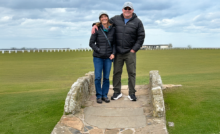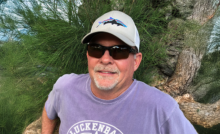Taking Advantage of your Advantage
When I first learned the Golf Course Superintendent position at Northland Country Club was going to be available, I set out to learn as much about the course as possible. I played the course, walked the course, researched the course’s history and walked the course again. I found a golf course with a great history and wonderful architecture, but I also found a course that was missing something.
Golf is a game best played on firm surfaces. The great golf courses of the Golden Age Architects were designed with this in mind. Think of any sport played on turf and you can bet it is a more enjoyable game when played on an ideal surface. Yet sometime, over the years, the idea of what a golf course should be and the conditions under which the game should be played have been lost. Golf, as with any other sport, is infinitely more enjoyable when played on a proper surface, a firm surface. If my interview preparations at Northland led me to one thing, it was that the golf course was too good to not have proper playing surfaces. When I was hired as Golf Course Superintendent I began, with the support of my staff, Green Committee and Board of Directors, to formulate a plan for changes the course needed and how this transition would be made. Our operating budget is modest and breaking the bank was not an option. I immediately knew that our location and climate were going to provide some distinct advantages that, when taken advantage of, would help us get the course where it needed to be.
Many reading this probably have no idea where Duluth, Minnesota is located. Find the western most point of Lake Superior and you cannot miss Duluth. Northland Country Club sits on the bluff overlooking Lake Superior – the direct exposure to the world’s largest and coldest body of fresh water creates an interesting climate. It is a climate in which 80 degrees in July is hot and 90 degrees comes along maybe once or twice a year. When talking with my peers, I often hear some form of the comment, “what an advantage it must be to grow grass in your climate”. Yes, it is an advantage, but only if you take advantage of the advantage.
From my first day as a superintendent, my staff and myself have made water management the core of our golf course management program. Developing a proper playing surface had to begin with water management. While water is essential to turf, it is in no way a cure all and has the potential to cause a superintendent more problems than it can solve. Being in a climate cooled by Lake Superior allows us to use our water very judiciously. “When in doubt, do not water” is the irrigation motto we have lived by for three seasons. Our unique climate presents us this advantage when it comes to water management and we do our best to use this advantage. Irrigation programs on our greens are built around deep, infrequent irrigation cycles. It is a program, which best takes advantage of Duluth’s cool climate. The greens at Northland Country Club are like many classic era golf courses: original push-up construction with a four-inch layer of sand developed by years of topdressing. The native soils are heavy clay and therefore subsurface drainage of the greens is poor at best. In our cool climate, deep and infrequent watering regularly allows us to go up to a week without irrigation. In the days after an irrigation cycle, my staff and I watch for signs the turf is once again in need of water. It is then, and only then, we will discuss the next irrigation cycle. The cool high and low temperatures allow the signs of moisture stress to serve as a signal to begin thinking about irrigating rather than a sign of turf loss. I cannot tell you how many times we have been able to hold off on needed irrigation, due to cool temps, only to receive the necessary moisture in the form of rain. Implementing a program of this nature takes an understanding of your turf and certainly requires a feeling out process until reaching a comfort level. By taking advantage of this advantage, we have created a domino effect, which has drastically improved the condition of our greens and allowed us to significantly cut back on inputs.
Inputs, or the lack thereof, are another way we take advantage of our advantage. There are many superintendents out there who spray a regular and necessary fungicide program on greens, tees and fairways. Climate dictates the need to spray fungicides or significant disease and turf loss could result. A climate cooled by Lake Superior does not present disease pressure requiring preventative applications of fungicides. Again, by taking advantage of our advantage we have drastically cut back on expensive fungicide use. This is not to say we have not sprayed any fungicide, but we are willing to exhaust all cultural control methods before going to a spray. We are also not afraid to see a little disease on the turf and by allowing disease to appear we know exactly where our thresholds lie. Due to our low disease pressure the only disease we really concern ourselves with is dollar spot. In this climate, dollar spot is never going to grow out of control overnight. This allows us the opportunity to look at the weather and any other factors affecting disease pressure before making a decision to go ahead and spray. Often times a small outbreak is deemed acceptable because a change in the weather, which will render the disease inactive, is just around the corner. In each of my three seasons at Northland, we have reduced fungicide applications. Take our greens as an example: my first season we set out on a regular bi-weekly fungicide program. By mid-August, nighttime temperatures were regularly in the low to mid 50’s and it was decided to bring the fungicide applications to and end.. In year two, we only sprayed a regular fungicide application on greens for 8 weeks in the middle of summer. This season we set out to see how far the envelope could be pushed, on our greens. The climate, water management, cultural practices and daily rolling all conspired to allow us to make just one fungicide application to the putting surfaces this summer. One more application was required in late September when pink snow mold appeared, but from bi-weekly to twice seasonally in two years is something of which we are all very proud.
In my first three seasons, we have drastically improved turf and playing conditions at Northland Country Club. Not only have we improved the course, but we have also built a strong team by adding staff and increasing wages. Improvements to the course and staff have been made with only a slight budget increase of 10% over the past three years, we have done this by taking advantage of our advantages.
Not everyone’s advantages are the same as ours. What works for us may not work in a different location. However, I encourage all of my colleagues to seek out your advantages, take advantage of them and see how it can make your course better.
Please follow turfgrass management at Northland Country Club at http://www.northlandgrounds.blogspot.com/. And on twitter at http://twitter.com/nccturf
Recent Posts
Memphis Country Club: A Golfer’s Study in Precision and Tradition
If you have ever teed it up at Memphis Country Club, you know this isn’t…
Foley Company attains GCSAA Silver Partner Status
Foley Company, a leader in turf equipment innovation and technology, affirms its support of the…
Harrell’s continues longstanding support of the GCSAA Foundation
Harrell’s LLC, a leading distributor of customized agronomic products for turfgrass since 1941, has donated…
City of Orlando Announces New State-of-the-Art Driving Range at Dubsdread Golf Course
The City of Orlando is excited to announce the construction of a brand-new, state-of-the-art driving…
Discover Puerto Rico for Great Golf Trips and After-Round Activities, Amenities
Golfers cannot live by the game alone which is why Puerto Rico provides the perfect…
Q&A with a Multi-talented Golf Course Architect – Part 2: Making the Rounds – Installment 39
This column features recollections of the author’s 37 years as a golf writer. These installments…



